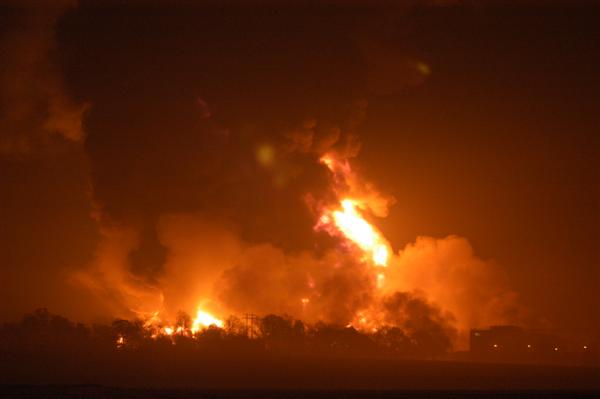|
FLACS
FLACS (FLame ACceleration Simulator) is a commercial Computational Fluid Dynamics (CFD) software used extensively for explosion modeling and atmospheric dispersion modeling within the field of industrial safety and risk assessment. Main application areas of FLACS are in petrochemical, process manufacturing, food processing, wood processing, metallurgical, and nuclear safety industries. FLACS has dedicated modules to simulate gas explosion, dust explosion and explosions involving chemical explosives like TNT. FLACS is also extensively used to simulate flammable and toxic gas dispersion. It was applied in the investigation of many high profile accidents such as Buncefield fire, Piper Alpha, TWA Flight 800,Sandia report on modeling TWA-800 tank explosion http://www.galcit.caltech.edu/resources/search_galcit?q=flacs and the Petrobras 36 platform. History FLACS software development started in-house in the early 1980s under the sponsorship program, Gas Explosion Safety (GSP), funded b ... [...More Info...] [...Related Items...] OR: [Wikipedia] [Google] [Baidu] |
Atmospheric Dispersion Modeling
Atmospheric dispersion modeling is the mathematical simulation of how air pollutants disperse in the ambient atmosphere. It is performed with computer programs that include algorithms to solve the mathematical equations that govern the pollutant dispersion. The dispersion models are used to estimate the downwind ambient concentration of air pollutants or toxins emitted from sources such as industrial plants, vehicular traffic or accidental chemical releases. They can also be used to predict future concentrations under specific scenarios (i.e. changes in emission sources). Therefore, they are the dominant type of model used in air quality policy making. They are most useful for pollutants that are dispersed over large distances and that may react in the atmosphere. For pollutants that have a very high spatio-temporal variability (i.e. have very steep distance to source decay such as black carbon) and for epidemiological studies statistical land-use regression models are also used. ... [...More Info...] [...Related Items...] OR: [Wikipedia] [Google] [Baidu] |
Buncefield Fire
The Buncefield fire was a major fire at an oil storage facility that started on 11 December 2005 at the Hertfordshire Oil Storage Terminal, located near the M1 motorway, Hemel Hempstead, in Hertfordshire, England. The terminal was the fifth largest oil-products storage depot in the United Kingdom, with a capacity of about 60 million Imperial gallons (273 million litres) of fuel. The terminal is owned by TOTAL UK Limited (60%) and Texaco (40%). The first and largest explosion occurred at 06:01 UTC near tank 912, which led to further explosions which eventually overwhelmed 20 large storage tanks. The emergency services announced a major emergency at 06:08 and a firefighting effort began. The cause of the explosion was a fuel-air explosion in a vapour cloud of evaporated leaking fuel. The British Geological Survey monitored the event, which measured 2.4 on the Richter scale. News reports described the incident as the biggest of its kind in peacetime Europe and certainly ... [...More Info...] [...Related Items...] OR: [Wikipedia] [Google] [Baidu] |
Fire Dynamics Simulator
Fire Dynamics Simulator (FDS) is a computational fluid dynamics (CFD) model of fire-driven fluid flow. The computer program solves numerically a large eddy simulation form of the Navier–Stokes equations appropriate for low-speed, thermally-driven flow, with an emphasis on smoke and heat transport from fires, to describe the evolution of fire. FDS is free software developed by the National Institute of Standards and Technology (NIST) of the United States Department of Commerce, in cooperation with VTT Technical Research Centre of Finland. Smokeview is the companion visualization program that can be used to display the output of FDS. The first version of FDS was publicly released in February 2000. To date, about half of the applications of the model have been for design of smoke handling systems and sprinkler/detector activation studies. The other half consist of residential and industrial fire reconstructions. Throughout its development, FDS has been aimed at solving practical ... [...More Info...] [...Related Items...] OR: [Wikipedia] [Google] [Baidu] |
Two-phase Flow
In fluid mechanics, two-phase flow is a flow of gas and liquid — a particular example of multiphase flow. Two-phase flow can occur in various forms, such as flows transitioning from pure liquid to vapor as a result of external heating, separated flows, and dispersed two-phase flows where one phase is present in the form of particles, droplets, or bubbles in a continuous carrier phase (i.e. gas or liquid). Categorization The widely accepted method to categorize two-phase flows is to consider the velocity of each phase as if there is not other phases available. The parameter is a hypothetical concept called Superficial velocity. Examples and applications Historically, probably the most commonly studied cases of two-phase flow are in large-scale power systems. Coal and gas-fired power stations used very large boilers to produce steam for use in turbines. In such cases, pressurised water is passed through heated pipes and it changes to steam as it moves through the pipe. The d ... [...More Info...] [...Related Items...] OR: [Wikipedia] [Google] [Baidu] |
OpenMP
OpenMP (Open Multi-Processing) is an application programming interface (API) that supports multi-platform shared-memory multiprocessing programming in C, C++, and Fortran, on many platforms, instruction-set architectures and operating systems, including Solaris, AIX, FreeBSD, HP-UX, Linux, macOS, and Windows. It consists of a set of compiler directives, library routines, and environment variables that influence run-time behavior. OpenMP is managed by the nonprofit technology consortium ''OpenMP Architecture Review Board'' (or ''OpenMP ARB''), jointly defined by a broad swath of leading computer hardware and software vendors, including Arm, AMD, IBM, Intel, Cray, HP, Fujitsu, Nvidia, NEC, Red Hat, Texas Instruments, and Oracle Corporation. OpenMP uses a portable, scalable model that gives programmers a simple and flexible interface for developing parallel applications for platforms ranging from the standard desktop computer to the supercomputer. An application built wi ... [...More Info...] [...Related Items...] OR: [Wikipedia] [Google] [Baidu] |
Unix
Unix (; trademarked as UNIX) is a family of multitasking, multiuser computer operating systems that derive from the original AT&T Unix, whose development started in 1969 at the Bell Labs research center by Ken Thompson, Dennis Ritchie, and others. Initially intended for use inside the Bell System, AT&T licensed Unix to outside parties in the late 1970s, leading to a variety of both academic and commercial Unix variants from vendors including University of California, Berkeley (Berkeley Software Distribution, BSD), Microsoft (Xenix), Sun Microsystems (SunOS/Solaris (operating system), Solaris), Hewlett-Packard, HP/Hewlett Packard Enterprise, HPE (HP-UX), and IBM (IBM AIX, AIX). In the early 1990s, AT&T sold its rights in Unix to Novell, which then sold the UNIX trademark to The Open Group, an industry consortium founded in 1996. The Open Group allows the use of the mark for certified operating systems that comply with the Single UNIX Specification (SUS). Unix systems are chara ... [...More Info...] [...Related Items...] OR: [Wikipedia] [Google] [Baidu] |
Statoil
Equinor ASA (formerly Statoil and StatoilHydro) is a Norwegian state owned enterprise, state-owned multinational energy company headquartered in Stavanger. It is primarily a petroleum company, petroleum company, operating in 36 countries with additional investments in renewable energy. In the 2020 Forbes Global 2000, Equinor was ranked as the 169th-largest public company in the world. the company has 21,126 employees. The current company was formed by the 2007 merger of History of Statoil (1972–2007), Statoil with the Hydro Oil & Gas, oil and gas division of Norsk Hydro. As of 2017, the Government of Norway is the largest shareholder with 67% of the shares, while the rest is public stock. The ownership interest is managed by the Ministry of Petroleum and Energy (Norway), Norwegian Ministry of Petroleum and Energy. The company is headquartered and led from Stavanger, while most of their international operations are currently led from Fornebu, outside Oslo. The name ''Equinor'' ... [...More Info...] [...Related Items...] OR: [Wikipedia] [Google] [Baidu] |
Norsk Hydro
Norsk Hydro ASA (often referred to as just ''Hydro'') is a Norwegian aluminium and renewable energy company, headquartered in Oslo. It is one of the largest aluminium companies worldwide. It has operations in some 50 countries around the world and is active on all continents. The Norwegian state owns 34.3% of the company through the Ministry of Trade, Industry and Fisheries. A further 6.5% is owned by Folketrygdfond, which administers the Government Pension Fund of Norway. Norsk Hydro employs approximately 35,000 people. Hilde Merete Aasheim has been the CEO since May, 2019. Hydro had a significant presence in the oil and gas industry until October 2007, when these operations were merged with Statoil to form StatoilHydro (in 2009 changed back to Statoil, which is now called Equinor). History First steps with fertiliser Financed by the Swedish Wallenberg family and French banks, the company was founded on December 2, 1905 as Norsk hydro-elektrisk (lit. Norwegian hydro-electri ... [...More Info...] [...Related Items...] OR: [Wikipedia] [Google] [Baidu] |
Mobil
Mobil is a petroleum brand owned and operated by American oil and gas corporation ExxonMobil. The brand was formerly owned and operated by an oil and gas corporation of the same name, which itself merged with Exxon to form ExxonMobil in 1999. A direct descendant of Standard Oil, Mobil was originally known as the Standard Oil Company of New York (shortened to Socony) after Standard Oil was Standard Oil Co. of New Jersey v. United States, split into 34 different entities in a 1911 Supreme Court decision. Socony merged with Vacuum Oil Company, from which the Mobil name first originated, in 1931 and subsequently renamed itself to Socony-Vacuum Oil Company. Over time, Mobil became the company's primary identity, which incited another renaming in 1963, this time to Mobil Corporation. Mobil credits itself with being the first company to introduce Pay at the pump, paying at the pump at its gas stations, the first company to produce jet aviation fuel, as well as the first company to intr ... [...More Info...] [...Related Items...] OR: [Wikipedia] [Google] [Baidu] |
Esso
Esso () is a trading name for ExxonMobil. Originally, the name was primarily used by its predecessor Standard Oil of New Jersey after the breakup of the original Standard Oil company in 1911. The company adopted the name "Esso" (the phonetic pronunciation of Standard Oil's initials, 'S' and 'O'),Don't ignore history by Robert Sobel on Barro's, 7 Dec 1998 to which the other Standard Oil companies would later object. Standard Oil of New Jersey started marketing its products under the Esso brand in 1926. In 1972, the name Esso was largely replaced in the U.S. by the Exxon brand after the Standard Oil of New Jersey bought , while the Esso name remained widely used elsewhere. In most of the wo ... [...More Info...] [...Related Items...] OR: [Wikipedia] [Google] [Baidu] |








